Huawei Honor 6 Review
by Andrei Frumusanu & Joshua Ho on September 12, 2014 9:00 AM EST- Posted in
- Smartphones
- Huawei
- Android
- Mobile
- Honor 6
Like almost every other OEM out there, Huawei differentiates its Android implementation through a custom skin and framework - called EmotionUI. The Honor 6 comes with version 2.3 and that is the one I'll be reviewing. Again I'd like to mention that this variant came with a lot of pre-installed Chinese vendorware that may not be included in the international version of the phone. Thankfully, Huawei more or less managed to separate (willfully or not) the obvious core parts of the software experience from the added parts that may be Chinese exclusives.
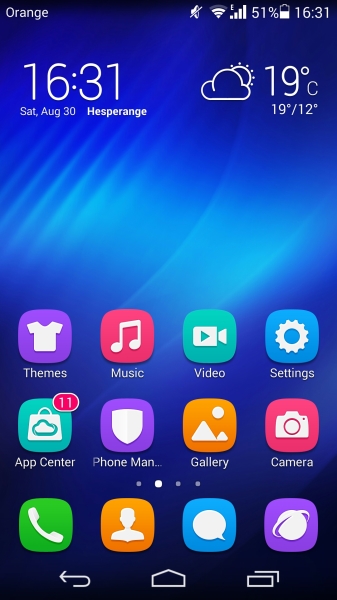

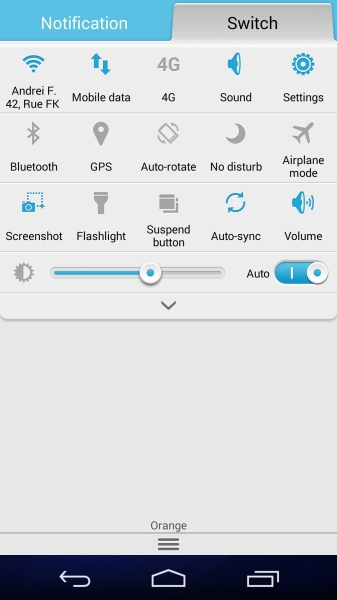
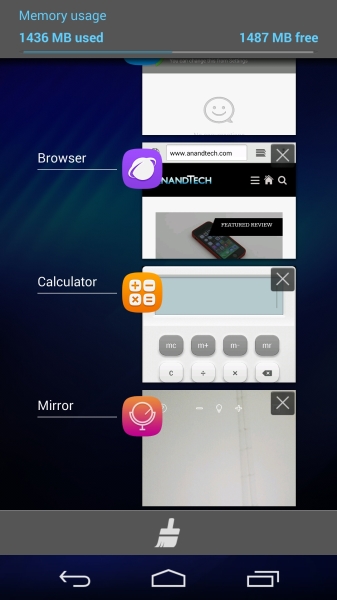
The design of the default UI theme employs a simplistic yet accentuated approach. The various elements remind of a mash between pre-iOS 7 with modern Android. There is a general emphasis on blue accents. Functionally, Huawei has kept it simple and has not veered off from standard Android too much. The notification shade is separated into the actual notification area and the switch toggle panel. Unlike some OEMs the notification area is clean and all additional toggles controls were added to the dedicated switch panel, which I find a better alternative than the implementations of other vendors while still adding value to stock Android.
One thing that I found endlessly infuriating is that if you do swipe right to, or use two fingers to pull down the switch panel down, it would remain in that view until you swiped/tap it back left to the notification view even if you have dismissed and pulled down the notification panel again with just one finger. A very odd inconsistency that was hard to get used to when quickly trying to view one's notifications.
The biggest differentiator to stock Android is probably the home launcher: it lacks an application drawer and thus makes the home screens themselves the application drawer as in iOS. I found myself endlessly creating folders and trying to manage the application icons on the home screen to keep it in a somewhat reasonable order and cleanliness. Of course there is nothing preventing one from installling a custom launcher replacing Huawei's. The stock launcher offers little reason as to why one should keep it as it offers little added functionality. In a sense, it's a plus for simplicity's sake but can quickly get overwhelming when you start installing a lot of apps which you don't regularly use.
What most people will notice is that use of rounded square background for any and all application icons throughout the OS. This is unfortunately an aspect you will like, hate or simply feel indifferent about, but cannot be changed. The system tries to generate a fitting background to an application's icon - most times it work, but sometimes it fails and this results in an odd look where the original icon seems cut off and plastered on top.
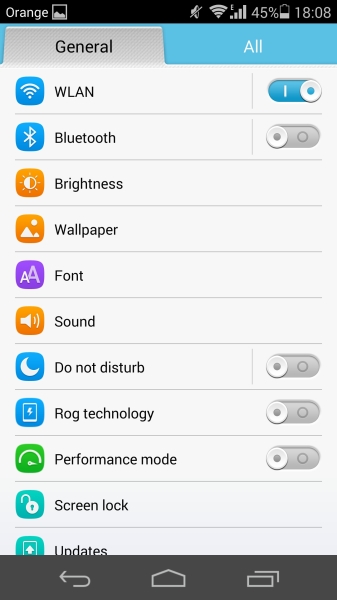
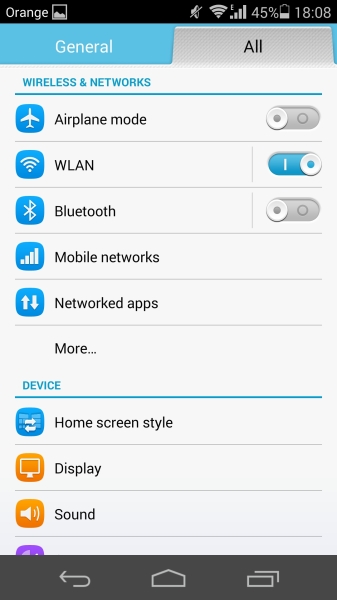
The settings screen offers a simplified view with the most accessed items on a single page view. If you want to delve a bit deeper the complete settings page is available at a swipe. The categories are clean and well ordered. I don't have too much too say about it as it's pretty much what you expect from a well-implemented settings screen.
Here's where usually most OEM user interfaces stop their customization of the core aspects of the Android framework stop. But here's where it gets really interesting. On the main home screen is a shortcut to the so-called "Phone Manager", which is also accessible via the settings screen in its own category.
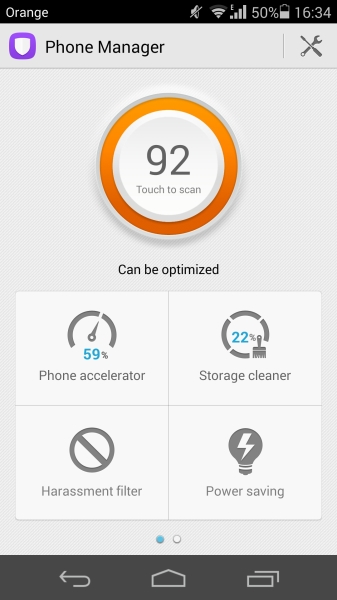

Here you can find various dubious options such as "Phone accelerator", "Storage cleaner" or even a built-in virus scanner. There's nothing too interesting in most of them, with the phone accelerator being nothing else than an active task manager for clearing memory. For the other items however what we find is the most extensive application permission manager I have seen ship on any Android device to date.
By default, any time you install an application on the device you would get prompted the usual permission acknowledgement dialog with a list of permissions that the developers feel they need to access. Huawei has built a framework on top of that extending that permission management. With the the built-in permission manager you are able to fully control apps on a per-permission basis and decide whether to grant, revoke, or always prompt for whenever an application requests a function needing a specific permission.
This is what Google already promises to deliver with Android L, but what seems to me that it goes one step further by allowing you detailed management any time you wish, instead of just runtime prompting (Google has yet to finalize L so this may be subject to change).
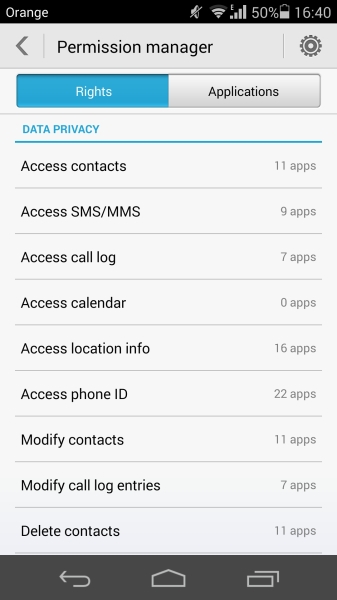
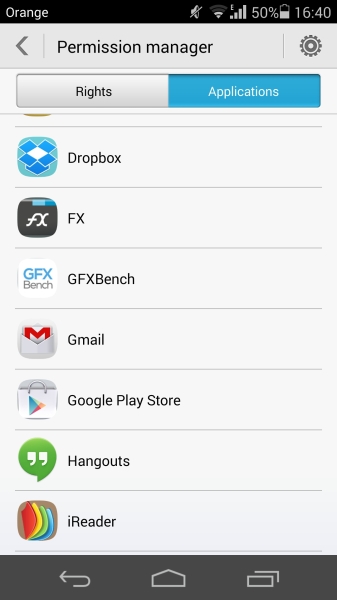
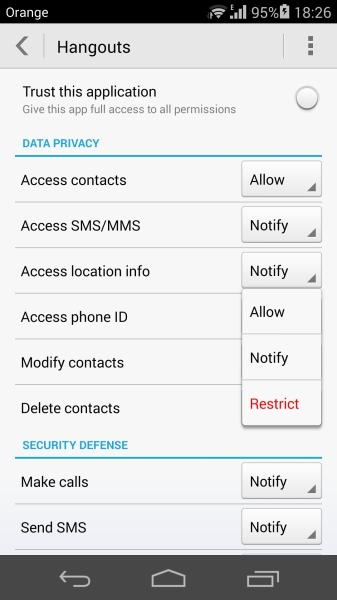

A much-needed feature on Android that Huawei provides is both the notification manager and the startup manager: it allows a centralized settings screen that controls what applications are allowed to push notifications onto the notification shade, and similarly to that, which applications are allowed to be launched at boot. These are a boon for fighting adware and annoying applications which like to clutter and needlessly bloat the phone.
The framework also provides fine-grained network connectivity permissions, allowing one to manage which apps are able to access the cellular or Wi-Fi networks while offering a clean view of each app's data usage.
Needless to say, Huawei has really impressed me with what they've provided in terms of rights management in EmotionUI. It can be easily be viewed as the new high standard which other OEMs, and hopefully Google too, should strive to achieve in all their future Android phones.
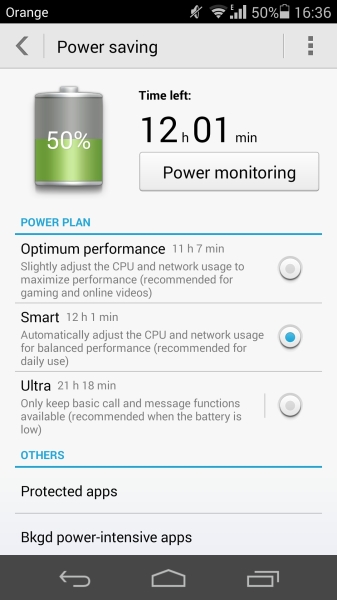
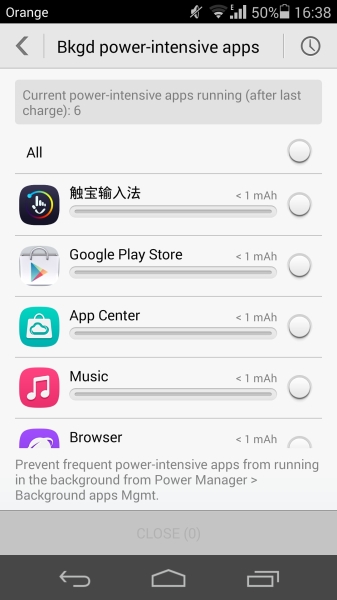
The power controls are also a interesting feature on the phone. We have a standard performance profiles that we might find on some phones. The real difference between the "Smart" and "Optimum Performance" settings is that the latter allows for lower HMP threshold parameters on the SoC and slightly adjusted higher target scaling frequencies. In my experience and what we'll see expanded on in the in-depth SoC review, is that it's not worth it to ever use the performance setting as it gives marginable performance benefits that may not even be noticeable to the user and have negative effects on the battery longevity of the phone. The "Ultra" setting delivers a similar experience to Samsung's UPSM, limiting all applications beyond the core phone functions.
Again, similarly to the rights management settings, Huawei exposes fine-grained controls over power usage of applications. In this case it's not the performance of said apps that is limited, but their life-cycle which gets stopped whenever they get sent into the background or when the screen is off. The user is able to explicitly protect apps from being killed by the memory manager in such cases. If an unprotected application is using excessive CPU cycles in the background, a warning notification is prompted to the user and a more detailled view with a power usage estimate can be brought up for further investigation. Again, it seems that Huawei is providing counter-measures for poorly-written apps that can silently eat away at a device's battery.
Next, let's move on to the "added value" applications that are pre-installed with the phone.










59 Comments
View All Comments
DIYEyal - Saturday, September 13, 2014 - link
I found a typo in the battery life page: "I think this is due the phone having quite good thermal dissipation charateristics ."akshayprbhu - Friday, October 10, 2014 - link
that is not a typo. The phone is having good thermal dissipation as it is cooler than similar spec phones when a performance test was done! Youtube for more proof...lilmoe - Saturday, September 13, 2014 - link
Great review of what really matters. I especially liked the in-depth analysis of the SoC and its platform power in comparison to others. Looking forward to future reviews."Ideally, it would be interesting to see a 720p mode on 1440p screens as it would offer perfect scaling, with one logical pixel being mapped to exactly four physical ones, without the need for interpolation and upscaling artifacts"
If Samsung ever decides to put a 1440p panel on the GS6, I seriously hope they allow a 720p mode in their power saving options. Even if pentile, It would be MUCH sharper than any other 720p AMOLED panel since it's up-scaled. Actually, I seriously interested to see how it would look like. Plus, the added performance and battery life would be legendary on a phone faster and more efficient than the current GS5. Totally intriguing.
lilmoe - Saturday, September 13, 2014 - link
Oh, this is just a suggestion. If you must use browser benchmarks to measure platform performance (sighs...), wouldn't it be better to use the stock browser since it's what most people use? You know, since the stock browser is usually more optimized for that specific device and generally performs better than Chrome. Using Chrome to see the difference of Android devices in comparison is OK since they'd be using the same browser running on the same OS, but definitely NOT OK in comparison with other platforms.Please correct me if I'm wrong, because I'm positive that I'm not.
aryonoco - Sunday, September 14, 2014 - link
Thanks for the great review, this was the first time that any publication has exposed the inner workings of a Hisilicon SoC, and you've done a great job of that. However I wanted to mention here that I strongly disagree with your analysis of the software.Designing software that's going to be used by mass users is a constant balancing act between exposing enough power to satisfy different user requirements and power users, and yet keeping the UI simple enough so that the vast majority of users are not overwhelmed by the array of features. The Permission Management feature here, similar to those baked into many custom ROMs goes well over the line and is a huge user experience disaster. To ship an OEM ROM with this, is begging for a deluge of support calls from clueless customers who have disabled things and then wonder why their phone doesn't work as intended.
I'm not saying that the current permission management scenario in Android is perfect, far from it. I don't think anyone has figured out the perfect balance of how to inform users about third party apps without scaring them, turning the notices meaningless, or overwhelming users.
One of Anand's greatest assets was his ability to articulate his vision of good UI in various products. Him and Brian could explain why certain choices were made (for example in terms of treatment of external storage on Android, or the design tradeoffs about non-replaceable batteries) and the guiding principles behind them. File managers are archaic and confusing to 90% of users. I know the tech-savvy AT readership will disagree, but the whole concept of files and directories are broken for average users, especially on a device like a phone, and they are better off being abstracted away from them. Your comments on file managers in KitKat, or your praise of Huawei's software "enhancements" shows a lack of understanding of where the line is when it comes to UX design.
I hope that now that Anand is gone, AT doesn't become a place where the writers are blind to the needs of average customers. We do not need Android to regress to the wild days of Gingerbread, or worse, Windows Mobile.
Ethos Evoss - Sunday, September 14, 2014 - link
Well, you complaining about huawei logo or writing missing and main thing is that you NEVER complained on iphones that they NEVER put writing on their phones but that is alright ? h ? people are so pathetic .. if apple wud make soome plastic dick sticking out from phone you guys would say that is fine bcos it is iphone and we will forgive that we will get used to it .. oohh jeezz naive peopleakshayprbhu - Friday, October 10, 2014 - link
the writings are a part of the mandatory regulations to denote the compliance with the telecom regulations. and it does not eat up too much space on the back.darkich - Sunday, September 14, 2014 - link
Absolutely great analysis. Andrei and Joshua, keep these top notch write ups coming!SeleniumGlow - Monday, September 15, 2014 - link
I was hoping that the Kirin processor would have a comparison with the MediaTek MT6592. But I guess there are some obvious differences in the Big Little implementation that will prevent it from being a good comparison.siberstorm - Monday, September 15, 2014 - link
The mediocre camera and obvious cutrate shoddiness (wtf the stabilization is just the 1080p field cut down to 720p with none of the rest of the sensor used, so ghetto) is unacceptable and this goes for the mate 7 as well. So bye bye huawei. I am still interested in the lenovo vibe z2 pro aka k920 and would love a review of that phone, but the chances of lenovo sending one to anandtech are slim, considering they arent gunning for the global market like huawei is.